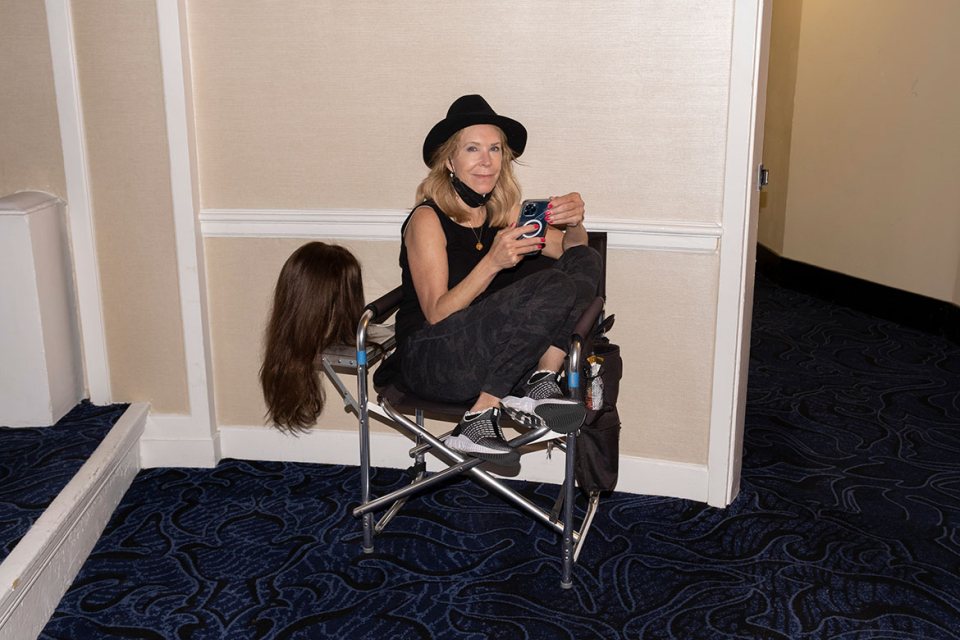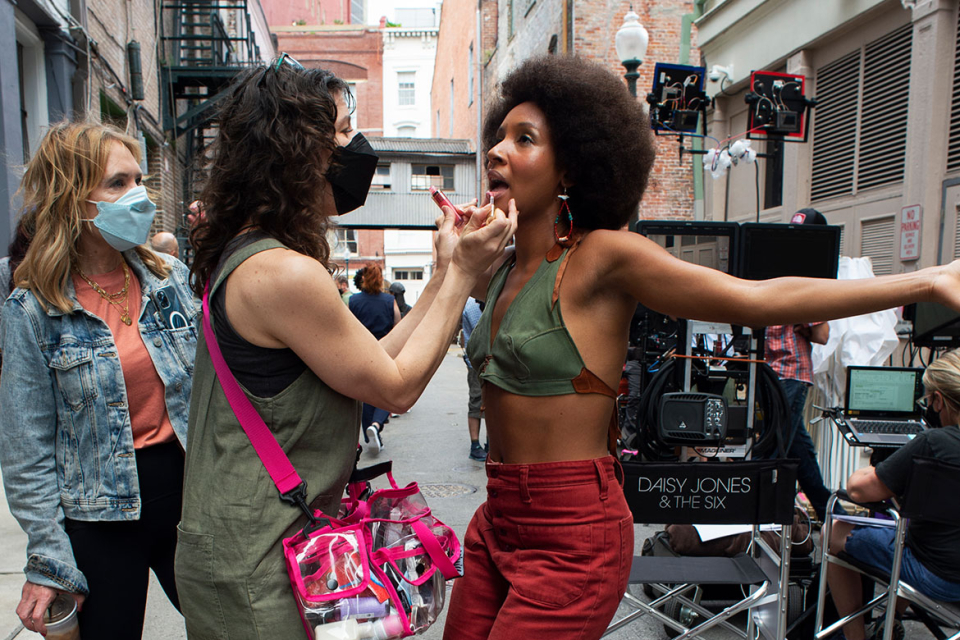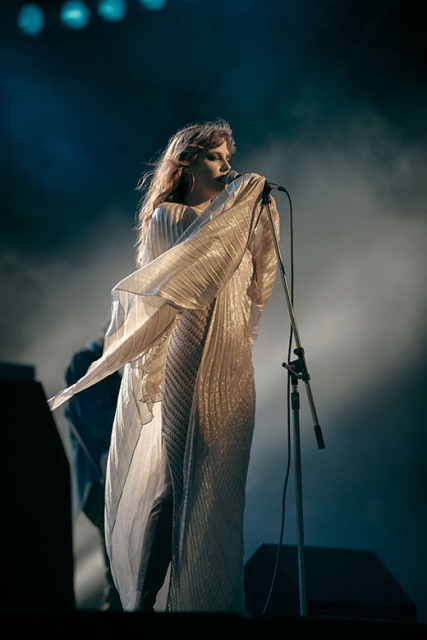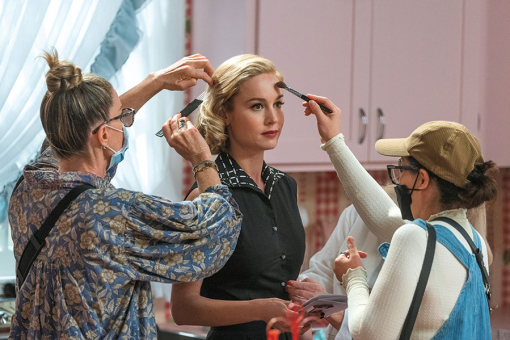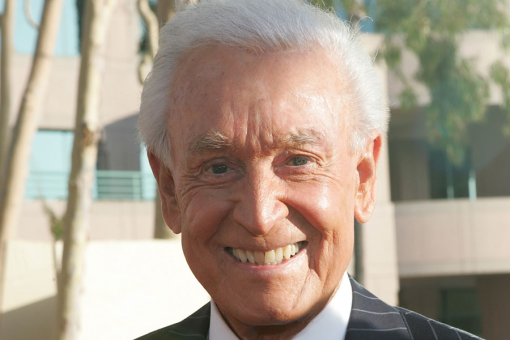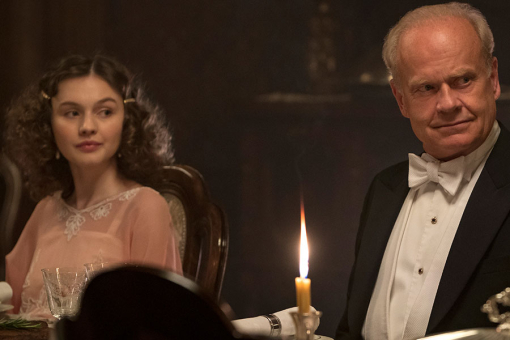She was a free spirit blessed with a carefree beauty. But she struggled with inner demons: a broken childhood, abandonment and a strong need to be noticed. So when fame came calling, Daisy Jones responded the only way she could — with unbridled passion and raw talent, fueled by pills, booze and weed.
Her story is a 1970s snapshot in time, told in Daisy Jones & the Six, Prime Video's limited musical drama about a band whose rise to superstardom is inspired by real-life stories of rock stars from the day. (Daisy herself, played by Riley Keough, is thought to be loosely based on Stevie Nicks of Fleetwood Mac.)
To tell this rockin' retro tale — which is based on the best-selling novel by Taylor Jenkins Reid — a cadre of artists in makeup, hairstyling, costume design and production design were tasked with bringing the '70s to life. To do so, they took a deep dive into the L.A. music scene, in the iconic bars of the Sunset Strip and the secluded homes of Laurel Canyon. And they recreated looks featuring long, flowing locks (on both men and women); low-riding and bell-bottomed pants; wedge shoes; sheer flowered kimonos; huge hoop earrings and plenty of feathers and fringe. Emmy recently spoke to four of these talented professionals.
Mary Ann Hennings - HAIR DEPARTMENT HEAD
First, let's get one thing straight: when it comes to styling Hollywood hair, men's heads are more challenging than women's. "Men tend to see things that other people are not seeing," Mary Ann Hennings confides. "Television soundstages are so brightly lit that you often get lots of questions: 'Is my hair thinning? Is it receding?'"
Assuaging such concerns is just part of the job, which Hennings has been doing since the early '90s. That's when a client, actress Marilu Henner, talked the stylist into taking on a new customer, her boyfriend John Travolta. Since then, she's earned dozens of credits on shows and films such as Modern Family, Brooklyn Nine-Nine and Where the Crawdads Sing.
For her work on Daisy Jones & the Six, Hennings talked at length with the show's producers. "I knew going in that this was a passion project for Lauren [Neustadter] and her husband Scott [Neustadter; both are executive producers]. They had been working on this for several years."
She also had lots of discussions with the cast, especially actresses Riley Keough, who plays lead singer-songwriter Daisy, and Camila Morrone, who portrays Camila, the wife of the band's other lead, Billy Dunne. Both women are in love with Billy, who's played by Sam Claflin.
"We wanted to make sure that Camila's character was the complete opposite of Daisy's," Hennings explains. In terms of hair, that meant long, mostly straight brown hair for Camila, and long reddish waves and bangs for Daisy. (The real-life Camila had bangs; Hennings added extensions to her hair, so the bangs disappeared.)
Men's coifs in the 1970s tended toward longer lengths, and to style the actors, Hennings used vintage blow dryers that came with a small brush attached. "Back in the day guys would use these things," she explains, "and get a fuller look."
During production, one of the challenges was managing with jumps in time, as scenes are typically not shot chronologically. "I had to deal with so much in terms of continuity," Hennings says. "I had to plan ahead for all my different looks."
And then there was the performance factor. "For Billy, I could curl his hair, but when he performed, his hair would become a stringy, sweaty mess. While they were lighting for the reshoot, I would pull him over and dry-curl his hair again."
Her fave tools for all the looks — besides the dependable Dyson blow dryers and straightening irons — were hot rollers, the hard plastic ones. "The minute you took them out, everyone looked like they were right back in the '70s!"
Rebecca Wachtel - MAKEUP DEPARTMENT HEAD
To transport a cast to the 1970s, the first job for a makeup artist is to make all traces of current trends disappear. Yes, we're talking tattoos.
Since Daisy stars Riley Keough and Sam Claflin both have several tattoos, makeup artist Rebecca Wachtel — whose many credits include Truth Be Told, Pretty Little Liars and Nip/Tuck — had to use full body makeup every day. Then, to create the look of a California tan — popular in the '70s, when skin cancer wasn't yet on anyone's radar — she applied a bronzer from the neck down. "On Sam, I used three different tinted face oils and a cream bronzer so that he had that natural rugged look," she says.
At the start of the story, Daisy is meant to be a glowing natural beauty — think a young Joni Mitchell. "Back then people didn't wear a lot of makeup," says Wachtel, who achieved Daisy's natural rosy hue with two tones of foundation, the lighter one in the center of her face and the darker one around the edges. She then built on that with cream bronzers on Keough's cheeks, cream blushers on the bridge of her nose and highlighter on her cheekbones and the apples of her cheeks.
Appearances begin to change for both Daisy and Billy as they deal with drug addiction. For Billy, Wachtel added redness around the actor's eyes and nose, increased the shine on his skin and applied a menthol stick to make his eyes appear red and glassy.
Daisy's downfall is more substantive, as is her drug use, and Wachtel was tasked with creating a big look to indicate the character's breakdown. "It's right before her final show, and she's really upset," Wachtel relates. "People now probably don't remember, but back in the day people used to heat up eyeliners, using a lighter, to make them more liquid. So we created this moment where she's doing that and watching the flame on the eyeliner."
Daisy ends up using her finger to smear the liner around her eyes, somewhat like war paint, adding to the drama.
"They asked me to create something that was very centerpiece," Wachtel says, "and I think we did that."
Denise Wingate - COSTUME DESIGNER
Holed up in a hotel room, waiting out a hurricane, Denise Wingate got a book suggestion from a producer friend. It was the novel Daisy Jones & the Six. "I read the book in one sitting and knew I had to work on this project," Wingate says.
Her own history as the stylist for The Bangles back in the '80s gave her an insider's view of life with a rock band. "I was on the road with them for thirteen months straight," she says. "It was a lot of work, but who cares? I was twenty-two and having a great time."
Wingate went on to amass numerous credits in TV and film, including Wedding Crashers and Live Free or Die Hard and the original Melrose Place. To prepare for Daisy Jones, she created her own book of costumes for each character. "I knew they wanted it to look very realistic, nothing costume-y about it."
The series travels from Pittsburgh in the 1960s ("using looks with blues and grays") to L.A. in the 1970s ("very Kodachrome"). But after four weeks of prep, the start of the pandemic brought everything to a standstill.
"I don't think anyone realized we were going to shut down for as long as we did," she says, "but I never stopped working. I went to flea markets every Saturday and Sunday for a year, collecting vintage stuff."
Wingate's influences included a young Linda Ronstadt — halter tops, short shorts, hoop earrings — Joni Mitchell and even Cher. "Riley sent me a picture of Cher in her Gregg Allman days [the couple was married 1975–78], wearing a Navajo blanket coat with a fur collar and a matching halter. No way was I going to find that, so I had my seamstress make it.
"We were certainly influenced by Stevie Nicks," she adds, "while not copying her completely. But she had a great sense of style, using old kimonos and leotards with flowing skirts."
For the scene in which the band shoots its iconic "Aurora" album cover, Wingate pulled out all the stops, having a seamstress create — completely by hand — a floor-length white chiffon dress for Daisy. "It was sheer and lightweight and perfect." The day the scene was shot, in the California desert, "it was absolutely freezing! It had been snowing, so we had to put a fur coat over the dress. That was one of those 'kill your darlings' moments."
But, happily, another Daisy outfit had its moment in the sun. "For the band's final concert, we took a gold lamé Halston kaftan and cut it up the middle to make it into a cape, which was worn over a gold crocheted dress. When the light hit it, the outfit was flowy, ethereal. It was nothing short of perfect."
Jessica Kender - PRODUCTION DESIGNER
A decision was made early on to shoot Daisy Jones & the Six in as many of the real locales mentioned in the book as possible. But real life can have its downsides.
"The actual places have the ghost of authenticity, and actors can really get something from that — some intangible quality," says Jessica Kender, whose production design has been seen on such series as Tiny Beautiful Things, Station 19 and Dexter. "But the country was just coming out of the Covid shutdown, which complicated everything."
When the production approached the Whisky a Go Go, the famous club on Sunset Boulevard, "the answer was, 'That's great,'" Kender relates. "'You have twenty-four hours.'"
Upon scouting the location, Kender discovered that the elevated cages where go-go dancers used to perform were no longer there and the original wallpaper was long gone. Suddenly, shooting in the club looked supremely challenging.
"Twenty-four hours to dress it, shoot it and return it to the way it was is not much time."
But they succeeded.
In adjacent Laurel Canyon, other challenges arose. Taking a crew of seventy-five to film in a tiny house in the scenic hillside corridor proved unworkable. "The houses there are really small, so we ended up shooting those canyon scenes over in Highland Park [a community in east L.A.]," Kender says. The production just had to import five tons of plants to make it look like a canyon dwelling.
One place that did work perfectly was Sound City Studios in Van Nuys, the time-honored recording venue in L.A.'s San Fernando Valley that was home to such artists as Neil Young, Tom Petty and the Heartbreakers, Elton John and Fleetwood Mac (the band on which The Six is loosely based). "We cut their album in the actual Sound City."
To bring greater authenticity to the sets, Kender used iconic imagery from the '70s as inspiration. "When we painted the band's house, I was using the color palette from a classic Crosby, Stills & Nash album cover."
And to shoot the band's final concert, the crew set up a gigantic vintage stage at Tad Gormley Stadium in New Orleans. But, as they were prepping, a hurricane blew through. "Naturally, it took the roof off the stage and ripped a hole in a hand-painted scrim that was made for the production."
Still — and to her credit — Kender is the type of person who plans for all contingencies. She'd already had a second scrim made. "I've learned that when you can, it always helps to have a backup."
The interviews for this story were completed before the start of the WGA and SAG-AFTRA strikes.
This article originally appeared in emmy magazine #7, 2023 under the title, "Rock Odyssey."


